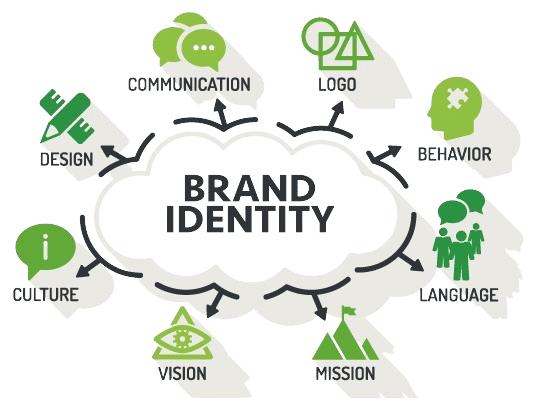CREATIVE
BRAND IDENTITY
Brand Identity is a crucial aspect of any business, as it creates a visual and emotional connection with customers.

A brand identity is a combination of various components, including tone, design, and logo. The tone of a brand refers to the language and messaging used to communicate with customers, which should reflect the brand's personality and values. Design elements such as color, typography, and imagery are also critical components of brand identity, as they help to visually convey the brand's message and differentiate it from its competitors. The logo is perhaps the most recognizable aspect of a brand and is used to symbolize the brand and create a memorable visual representation that can be easily recognized by customers.
Creating a strong brand identity requires a deep understanding of the brand and its target audience, as well as careful planning and execution. Our goal as a branding agency is to help our clients develop a brand identity that is both unique and memorable, one that truly represents the essence of their business and sets them apart from their competitors. Brand identity is an essential aspect of any business, as it creates a visual and emotional connection with customers. A strong brand identity can help businesses differentiate themselves from their competitors, build brand awareness and loyalty, and ultimately drive business success.
Brand Identity is a crucial aspect of any business, as it creates a visual and emotional connection with customers. It's the face of the brand, the way it is perceived by customers and what sets it apart from its competitors. A strong brand identity can have a profound impact on customer behavior, making it more likely that they will remember and choose the brand over others.

CREATIVE PLATFORM
A creative platform serves as the guiding blueprint for a brand's marketing materials and campaigns, unifying their creation and distribution across various channels. It outlines key messages, tone, and aesthetic, ensuring consistency for a strong brand identity. This platform aligns marketing efforts, amplifying impact and effectiveness by establishing the brand's voice and emotional rapport with the audience. Derived from the brand's mission, values, and audience, it communicates uniqueness and positioning. Clear guidelines aid the creative team, eliminating ambiguity and maintaining consistency. Its flexibility allows for updates, ensuring relevance and staying ahead in a dynamic market. Crucial for any brand, a well-defined creative platform fosters a robust identity and deeper audience connection, enhancing marketing impact.
UX/ INTERFACE DESIGN
UX/interface design is pivotal in defining a product or service’s triumph. It centers on understanding user needs, expectations, and preferences to craft a seamless and intuitive experience. This involves exhaustive research, testing, and iteration, ensuring the final product aligns with users’ requirements.
Complementing UX, UI design focuses on the visual and interactive aspects of a product. It utilizes color, typography, and icons to create an aesthetically pleasing interface. A well-designed UI augments user engagement, while a poor one can deter interaction and lead to frustration.
The synergy between UX and UI determines a product’s success. UX ensures user-friendliness, while UI adds visual appeal, making the experience both intuitive and visually engaging. For a triumphant product, these design facets must collaborate harmoniously, understanding both the user’s objectives and the product’s essence to deliver a satisfying, functional design.
SOCIAL ENGAGEMENT
Social engagement is an important aspect of digital marketing that helps businesses to build relationships with their customers and followers. The process involves active participation in online communities, discussions, and social media platforms. It allows businesses to interact with their customers and followers in a meaningful way, creating a sense of community and building brand loyalty.
There are a number of ways that businesses can engage with their customers online, such as Twitter, Facebook, LinkedIn, websites, forums, and third-party review sites. Each of these platforms offers different benefits and opportunities for businesses to interact with their customers. For example, Twitter is ideal for short and quick updates, while Facebook is better suited for longer posts and more in-depth conversations. LinkedIn is the perfect platform for B2B businesses, while forums and websites offer the opportunity to discuss specific topics in greater detail.
Measuring the success of a brand's social engagement is an important part of the process. Businesses can track the number of likes, shares, and comments on their posts, as well as the number of followers they have on each platform. These metrics help to gauge the impact of a brand's social media efforts and can be used to fine-tune their approach for maximum impact.
Social engagement is an important tool for businesses that want to build strong relationships with their customers. By actively participating in online communities, businesses can create a sense of community, build brand loyalty, and connect with their customers in a meaningful way. Additionally, tracking the success of social engagement efforts helps businesses to fine-tune their approach and maximize the impact of their digital marketing efforts.

MIXED REALITY
Mixed Reality (MR) is a term that refers to the combination of physical and virtual worlds to create a seamless blend of the two. It is an innovative technology that combines the best of both worlds, providing a new level of interaction between people and their environment. Unlike Virtual Reality (VR), which is fully immersed in a virtual world, and Augmented Reality (AR), which adds digital elements to the physical world, MR combines the two to create a new reality that is both real and virtual.
MR can be used in a variety of fields, including education, gaming, entertainment, and manufacturing. For example, in education, MR can be used to create interactive learning experiences where students can interact with virtual objects as if they were real. In gaming, MR can provide a more immersive experience by incorporating the player's physical environment into the game. In entertainment, MR can be used to create new and exciting experiences that blur the lines between reality and fantasy. In manufacturing, MR can be used to provide workers with real-time information about the production process, improving efficiency and reducing downtime.
MR technology can be delivered through various devices, including smartphones, head-mounted displays, and specialized MR headsets. These devices use sensors and cameras to track the user's physical movements and environment, and then use software to create a virtual world that blends seamlessly with the real world. MR also makes use of haptic feedback, which is the sense of touch, allowing users to interact with virtual objects as if they were real.
MR holds great potential for the future, as it has the ability to revolutionize the way we interact with technology and the world around us. With its combination of the physical and virtual worlds, MR provides a unique and engaging experience that has the power to change the way we learn, play, and interact with each other.
Mixed Reality is an exciting and rapidly developing technology that offers a new level of interaction between people and their environment. With its ability to merge the physical and virtual worlds, MR provides a unique and engaging experience that has the potential to change the way we live, work, and play.





